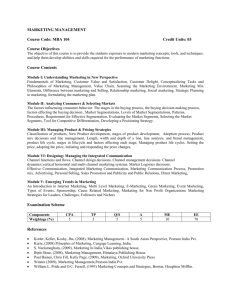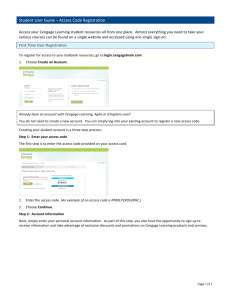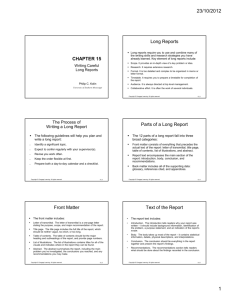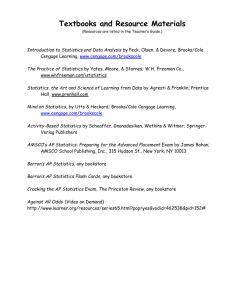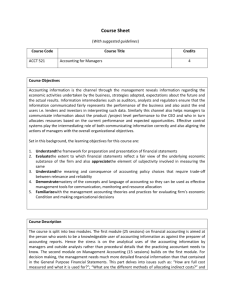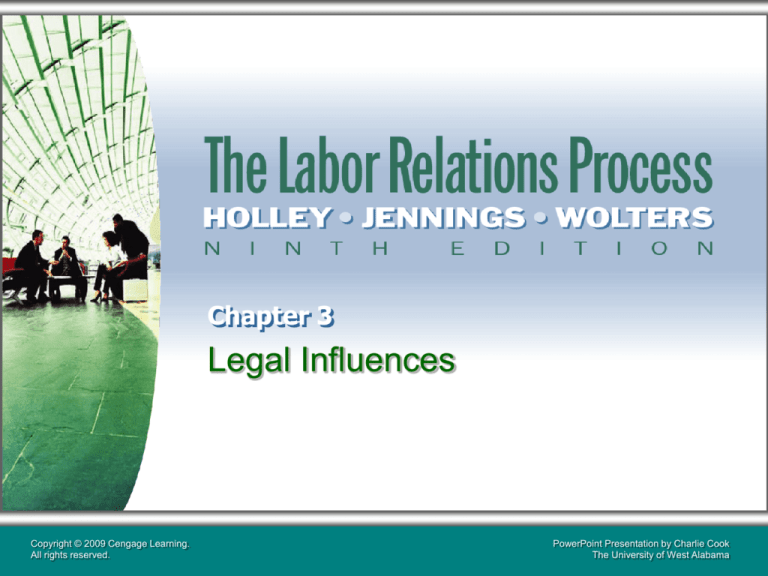
Chapter 3
Legal Influences
Copyright © 2009 Cengage Learning.
All rights reserved.
PowerPoint Presentation by Charlie Cook
The University of West Alabama
Origin of Labor Relations Law
• The Constitution
Article 1, Section 8 of the U.S. Constitution
The commerce clause grants right of Congress to regulate
interstate and international commerce.
Labor relations affect interstate commerce.
First Amendment
Grants rights of assembly, association, and free speech,
allows for the formation of unions.
Fifth Amendment
Provides due process rights.
Fourth Amendment
Federal laws preempt state and local laws.
© 2008 Cengage Learning. All rights reserved.
3–2
Origin of Labor Relations Law (cont’d)
• Common Law
Laws that are not derived from constitutional or
statutory laws
Employment-at-will doctrine
An employee or employer may terminate the employment
relationship at any time for any or no stated reason.
• Other Sources
Federal, state, and local statutory law
Judicial decisions
Regulations of federal, state, and local agencies
© 2008 Cengage Learning. All rights reserved.
3–3
Origin of Labor Relations Law (cont’d)
• Major Federal Labor Relations Laws
Railway Labor Act
Norris-La Guardia Act
Wagner (National Labor Relations) Act
Taft-Hartley (Labor-Management Relations) Act
Landrum-Griffin (Labor Management Reporting and
Disclosure) Act
© 2008 Cengage Learning. All rights reserved.
3–4
Origin of Labor Relations Law (cont’d)
• Labor Relations Administrative Agencies
National Labor Relations Board (NLRB)
Federal Mediation and Conciliation Service (FMCS)
U.S. Department of Labor (USDOL)
National Mediation Board (NMB)
National Railroad Adjustment Board (NRAB)
State and local administrative agencies
© 2008 Cengage Learning. All rights reserved.
3–5
Legal Interpretations Involving LaborManagement Relationships (1806-1931)
• Basis for the Legal System
Protection of employers’ tangible property rights
Protection of employers’ intangible rights to do
business and make a profit
• Criminal Conspiracy Doctrine
Common law interpretation held that it was illegal for
workers to join together to pressure employers for
better wages or working conditions.
Cordwainers case upheld criminal conspiracy.
© 2008 Cengage Learning. All rights reserved.
3–6
Legal Interpretations…(1806-1931)
• Civil Conspiracy Doctrine
Legal justification was that employees who acted in
concert (unlawful means) could inflict harm on other
parties even if the employees’ cause was just (lawful
ends).
Commonwealth v. Hunt (1842) ended the use of
criminal conspiracy but left in place civil conspiracy.
Courts continued to use jury trials and injunctions to
prevent concerted acts and the organization of
workers.
© 2008 Cengage Learning. All rights reserved.
3–7
Legal Interpretations…(1806-1931)
• Breach of Contract (Contractual Interference)
and the Use of the Labor Injunction
The concept that labor disputes constituted
interference in contracts between employers and
employees.
Yellow dog contracts
Employment contracts requiring an employee to refrain from
all union activities or be subject to dismissal.
Courts issued labor injunctions to stop the concerted
activities of employees.
© 2008 Cengage Learning. All rights reserved.
3–8
Legal Interpretations…(1806-1931)
• Application of Antitrust Legislation to Unions
Sherman Antitrust Act (1890)
Originally intended to prevent the restraint of trade by
regulating business monopolies.
Danbury Hatters (Loewe v. Lawlor) case
Supreme Court ruled that the labor organization’s use of the
boycott was an illegal restraint of trade.
Individual union members held liable for damages.
Unions supported Clayton Act (1914)—labor no longer
considered a commodity and injunctions were limited to
prevent injury to property.
© 2008 Cengage Learning. All rights reserved.
3–9
The Norris-La Guardia Act of 1932
• Protection of Workers’ Basic Rights
Limited the power of federal courts to issue
injunctions for employees’ lawful non-violence
concerted acts as anti-trust violations.
Declared yellow-dog contracts unenforceable.
Encouraged more impartiality by courts in labor
disputes.
• Shortcomings
No regulatory agency designated to enforce the act.
No specific unfair labor practices for employers.
© 2008 Cengage Learning. All rights reserved.
3–10
The National Labor Relations Act of 1935
• Also called the Wagner Act
Set national labor policy for labor peace and stability.
Encouraged the use of collective bargaining.
Protected employees’ rights to organization and
representation.
Established the National Labor Relations Board
(NLRB) to administer and enforce the act.
Defined the unfair labor practices of employers.
© 2008 Cengage Learning. All rights reserved.
3–11
Exhibit 3.1
Rights of Employees
Sec. 7—Employees shall have the right to self-organization,
to form, join, or assist labor organizations, to bargain
collectively through representatives of their own choosing, and
to engage in other concerted activities for the purpose of
collective bargaining or other mutual aid or protection, and
shall also have the right to refrain from any or all such
activities except to the extent that such right may be affected
by an agreement requiring membership in a labor organization
as a condition of employment as authorized In section 8(a)(3).
SOURCE: Labor-Management Relations Act, 1947, as amended.
© 2008 Cengage Learning. All rights reserved.
3–12
Labor Management Relations Act of 1947
• Also called the Taft-Hartley Act
Amended the NLRA to balance labor relations policy.
Union unfair labor practices were added to the act.
Set up union security options for states to allow:
Union shops (mandatory union membership)
Open shops (union membership by employee choice)
Agency shops (employees pay only for representation)
Allowed unions to be sued by employers for damages
resulting from illegal acts.
© 2008 Cengage Learning. All rights reserved.
3–13
Labor Management Reporting and
Disclosure Act of 1959
• Also called the Landrum-Griffin Act
Passed to protect union member rights and ensure
union democracy.
Required secret-ballot elections of union officers.
Required union membership approval in setting dues and
levying assessments.
Set federal financial reporting requirements.
Allowed neutral, secondary employers injured by unlawful
union activities to sue unions for economic damages.
© 2008 Cengage Learning. All rights reserved.
3–14
National Labor Relations Board (NLRB)
• Functions of the NLRB
To interpret and administer the LMRA
Actions and decisions are subject to federal court review.
Courts are to give deference to NLRB policies.
Responsibilities:
To prevent employer and union unfair labor practices.
To determine employees’ desire for representation.
© 2008 Cengage Learning. All rights reserved.
3–15
Composition of the NLRB
• Five-Member Panel
Appointed by the President; confirmed by the Senate.
Members serve staggered five-year terms.
Regional offices handle day-to-day affairs.
• General Counsel
Investigates and prosecutes unfair labor practice
charges.
Represents the Board in federal court when it seeks a
court order to enforce its decisions or whenever its
decisions are appealed.
© 2008 Cengage Learning. All rights reserved.
3–16
Persons Covered under the LMRA
• Sources and Reasons for Coverage
The commerce clause places most private-sector
employers and employees under the Act.
The NLRB may refuse to assert jurisdiction in cases
where it believes the effect on interstate commerce is
minor (de minimus).
Monetary standards for firms set thresholds for
coverage of employers.
© 2008 Cengage Learning. All rights reserved.
3–17
Persons Covered under the LMRA (cont’d)
• Groups Excluded from Jurisdiction of the Act:
Agricultural laborers
Individuals covered by the Railway Labor Act
Private domestic service employees
Individuals employed by parent or spouse
Public-sector employees
Independent contractors
Supervisors
© 2008 Cengage Learning. All rights reserved.
3–18
Exhibit 3.2
NLRB Jurisdictional Standards Determining Employer Coverage
under the LMRA
• Nonretail Business—Direct or indirect sales through others of goods to consumers in other
states (called outflow), of at least $50,000 a year; or direct or indirect purchases through others
of goods from suppliers in other States (called inflow), of at least $50,000 a year.
• Retail Business—At least $500,000 total annual volume of business.
• Office Building—Total annual revenue of $100,000, of which $25,000 or more is derived from
organizations that meet any of the standards except the indirect outflow and indirect inflow
standards for nonretail firms.
• Public Utility—At least $250,000 total annual volume of business, or $50,000 direct or indirect
outflow or inflow.
• Newspaper—At least $200,000 total annual volume of business.
• Radio, Telegraph, Television, and Telephone Firms—At least $100,000 total annual volume
of business.
• Private Health-Care Institutions—(e.g., hospital, HMO, clinic, nursing home)—At least
$250,000 total annual volume of business for hospitals; at least $100,000 for nursing homes,
visiting nurses associations, and related facilities; at least $250,000 for all other types of private
health-care institutions.
• Hotel, Motel, Residential Apartment Houses—At least $500,000 total annual volume of
business.
SOURCE: Office of the General Counsel, NLRB, A Guide to Basic Law and Procedures under the
National Labor Relations Act (Washington, D.C.: U.S. Government Printing Office, 1997), pp. 35–37.
© 2008 Cengage Learning. All rights reserved.
3–19
Exhibit 3.2
NLRB Jurisdictional Standards Determining Employer Coverage
under the LMRA
• Transportation Enterprises, Links, and Channels of interstate Commerce (e.g., Interstate
bus, truck)—At least $50,000 total annual Income from furnishing Interstate passenger and
freight transportation services or performing services valued at $50,000 or more for businesses
which meet any of the jurisdictional standards except the indirect outflow and inflow standards
established for nonretail firms. [Note: Airline and Railroad operations are covered under the
Railway Labor Act (RLA), not the LMRA, and thus are not subject to NLRB jurisdiction].
• Transit Systems—At least $250,000 total annual volume of business.
• Taxicab Companies—At least $500,000 total annual volume of business.
• Associations—The annual business of each association member is totaled to determine
whether any of the standards apply.
• Private Universities and Colleges—At least $1 million gross annual revenue from all sources
(excluding contributions not available for operating expenses due to limitations by the donor).
• Any Firm with a Substantial Impact on National Defense.
• U.S. Postal Service by enactment of the Postal Reorganization Act of 1970.
• Symphony Orchestras—At least $1 million gross annual revenue from all sources (excluding
contributions not available for operating expenses due to limitations by the donor).
• Social Service Organizations Not Covered under Any Other Standard—At least $250,000
gross annual revenue.
SOURCE: Office of the General Counsel, NLRB, A Guide to Basic Law and Procedures under the
National Labor Relations Act (Washington, D.C.: U.S. Government Printing Office, 1997), pp. 35–37.
© 2008 Cengage Learning. All rights reserved.
3–20
Concerted and Protected Employee Activity
• Concerted Activity
An action taken by or on behalf of two or more
employees to express a grievance.
Must be for a purpose contained in Section 7 of the LMRA.
Must be engaged in using lawful means; NLRB decides
lawfulness on case-by-case basis.
• The Interboro Doctrine
An employee working alone may be considered to be
engaged in concerted activity if seeking to enforce the
terms of a collective bargaining agreement.
© 2008 Cengage Learning. All rights reserved.
3–21
Exhibit 3.3
Unfair Labor Practice Procedure
Charge
Injunction
Investigation
Injunction
Complaint and Answer
WithdrawalRefusal to Issue
ComplaintSettlement
Hearing and Decision
Dismissal
Remedial Order
Other Disposition
Court Enforcement and Review
SOURCE: National Labor Relations Board.
© 2008 Cengage Learning. All rights reserved.
3–22
NLRB Unfair Labor Practices (ULPs)
• Charging Party
The party (union, employer, or individual) filing the
UPL charge
Represented by the General Counsel
• Respondent
The party accused of committing the violation
• Merit
A finding that a charge does involve a violation
• Administrative Law Judge (ALJ)
A judge who presides over the formal ULP hearing
© 2008 Cengage Learning. All rights reserved.
3–23
Types of Unfair Labor Practice Cases
• Routine Cases
Involve ULP charges that do not raise novel or new
issues of labor law.
Can be determined by existing Board policies and
legal principles.
• Lead Cases
Involve ULP charges that raise a new or novel labor
law issue or present the Board with the opportunity to
use the decision to create new policy or change
existing policy.
© 2008 Cengage Learning. All rights reserved.
3–24
Remedies in Unfair Labor Practices Cases
• Cease-and-Desist Orders
Instruct the respondent to stop the ULP.
Require respondent to post written notices of ULP.
• Affirmative Relief Action
Requires the respondent to provide a make-whole
remedy to individuals adversely affected by the ULP.
Reinstatement
Compensation and benefits
Promotion and restoration of seniority
An order to bargain in good faith
Decertification of the bargaining representative
© 2008 Cengage Learning. All rights reserved.
3–25
Federal Courts and NLRB ULP Decisions
• Courts must enforce decision if:
the decision is a reasonable interpretation of
congressional intent for the LMRA.
the decision is supported by substantial evidence
contained in the case record.
• Petition for Certiorari
A court of appeals’ decision appealed to the Supreme
Court when lower court decisions conflict with each
other.
© 2008 Cengage Learning. All rights reserved.
3–26
Assessment of the LMRA and the NLRB
• Current Labor Policy
Favors the powerful (employers) over the powerless
(employees).
Discourages unionism through foot-dragging.
Offers weak, insufficient statutory remedies.
Is grossly outdated and mismatched to the current
labor relations environment.
Laws (e.g., Beck rights) protecting individuals have
usurped the role of collective bargaining as the
employees’ voice.
© 2008 Cengage Learning. All rights reserved.
3–27
Unions’ View of the LMRA
• LMRA Reforms that Unions Want Now:
Greater access to employees by organizers.
Stronger penalties for employers’ ULPs against union
supporters.
Elimination of the use of permanent striker
replacements during economic strikes.
No weakening of the Section 8 prohibition of
employer domination and interference with union
organizations.
© 2008 Cengage Learning. All rights reserved.
3–28
Common Concerns about the NLRB
• Excessive slowness of case processing
Lack of standards and procedures
Lack of timely decisions on leading cases
Board member turnover and vacancies
• Initiatives to make NLRB more efficient:
Creating a three-board member ‘‘super panel’’ system
Creating ‘‘speed teams’’
Providing ‘‘settlement judges’’
Permitting ‘‘bench decisions’’
Creating advisory panels
Increasing the use of the injunction
© 2008 Cengage Learning. All rights reserved.
3–29
Transportation-Related Labor Relations
Laws (Railway and Airlines)
• Railway Labor Act of 1926
First comprehensive collective bargaining law
Originally covered only railway employees; amended
in 1936 to include airlines.
Major RLA disputes are subject to mandatory
mediation through the National Mediation Board
(NMB).
National Railroad Adjustment Board (NRAB)
Comprised of 18 union and 18 management members
Resolves minor disputes related to terms of the labor
agreement (which never expires)
© 2008 Cengage Learning. All rights reserved.
3–30
Deregulation Legislation
• Airline Deregulation Act of 1978
Ended government regulation of fares and routes.
Resulted in a rapid rise and fall in number of
nonunion carriers.
Increased mergers of major airlines.
Economic slowdowns and terrorist attacks further
exacerbated poor industry conditions.
• Staggers Rail Act of 1980
Increased flexibility in setting rates and service levels.
Strikes have declined but nonstrike actions have
increased.
© 2008 Cengage Learning. All rights reserved.
3–31
Additional Laws That Affect Labor Relations
• Employee Retirement Income Security Act of
1974 (ERISA)
Establishes minimum standards for the operation of
voluntarily established private-sector pension and
health benefit plans.
• The Americans with Disabilities Act of 1990
Requires “reasonable accommodation” of workers’
disabilities in all areas of the employment process.
• The Bankruptcy Act of 1984
Requires union and employer cooperation to avoid
bankruptcy filings and the alteration of contracts.
© 2008 Cengage Learning. All rights reserved.
3–32
Other Laws…(cont’d)
• The Worker Adjustment and Retraining
Notification (WARN) Act of 1988
Requires employers to notify employees and
communities of major workforce reductions.
• Racketeer Influenced and Corrupt Organizations
(RICCO) Act of 1970
Prohibits racketeering in an interstate commerce
organization.
Provides criminal penalties and allows for triple
recovery of damages.
© 2008 Cengage Learning. All rights reserved.
3–33
Employment Discrimination Laws and
Executive Orders
• Civil Rights Act of 1991
Prohibits discrimination on the basis of race, color,
religion, sex, or national origin.
• Age Discrimination in Employment Act of 1967
Prohibits discrimination against persons over 40
years of age.
• Executive Orders 11246 and 11375
Prohibits discrimination in the federal government and
by government contractors.
© 2008 Cengage Learning. All rights reserved.
3–34
Other Related Labor Relations Laws
• Vocational Rehabilitation Act of 1973
Section 503 requires affirmative action by government
contractors and federally funded educational
organizations in the employment of qualified disabled
persons.
• Uniformed Services Employment and
Reemployment (USSERA) Act of 1994
Protects the returning job rights of individuals called
to military service.
© 2008 Cengage Learning. All rights reserved.
3–35
Related Labor Relations Laws (cont’d)
• Social Security Act of 1935
Provides protection against loss of income resulting
from unemployment, old age, disability, and death.
Provides protection for survivors of workers.
• Fair Labor Standards Act of 1938
Sets minimum wage and overtime pay rates.
Prohibits child labor.
• Employee Retirement and Income Security Act
of 1974
Protects and guarantees employee retirements.
© 2008 Cengage Learning. All rights reserved.
3–36
Related Labor Relations Laws (cont’d)
• Occupational Safety and Health Act of 1970
Provisions regulate work place safety and the
handling of hazardous materials.
• Family and Medical Leave Act of 1993
Requires employers to provide unpaid leave for family
and medical purposes.
© 2008 Cengage Learning. All rights reserved.
3–37
Key Terms
•
•
•
•
•
•
•
•
•
•
•
•
•
•
•
•
•
•
U.S. Constitution
Common law
Employment-at-will (EAW) doctrine
Preemption doctrine
National Labor Relations Board (NLRB)
Labor Management Reporting and
Disclosure (Landrum-Griffin) Act
Federal Mediation and Conciliation Service
(FMCS)
U.S. Department of Labor (USDOL)
National Mediation Board (NMB)
National Railroad Adjustment Board (NRAB)
Criminal conspiracy doctrine
Commonwealth v. Hunt (1842)
Civil conspiracy doctrine
Labor injunction
Yellow-dog contract
Sherman Antitrust Act
Loewe v. Lawlor
Danbury Hatters
© 2008 Cengage Learning. All rights reserved.
•
•
•
•
•
•
•
•
•
•
•
•
•
•
•
•
•
•
•
•
Clayton Antitrust Act
Norris–La Guardia Act
Closed shop union security clause
National Labor Relations Act (NLRA)
Labor Management Relations Act (LMRA)
Union shop union security clause
Agency shop union security clause
Right-to-work law
The Board
NLRB jurisdiction
Postal Reorganization Act of 1970
Concerted and protected activity
Interboro doctrine
Charging Party
Respondent
Merit
Administrative Law Judge (ALJ)
Routine ULP case
Lead ULP case
Cease-and-desist order
3–38
Key Terms
•
•
•
•
•
•
•
•
•
•
•
•
•
•
•
•
Post written notices
Affirmative action
Petition for certiorari
Railway Labor Act (RLA) of 1926
Major dispute under the RLA,
Minor dispute under the RLA,
Employee Retirement Income Security Act
(ERISA)
Pension Benefit Guaranty Corporation
(PBGC)
Americans with Disabilities Act (ADA)
Bankruptcy Act of 1984
Worker Adjustment and Retraining
Notification Act (WARN)
Racketeer Influenced and Corrupt
Organizations Act (RICO)
Civil Rights Act of 1991
Age Discrimination in Employment Act of
1967
Executive Order 11246
Executive Order 11375
© 2008 Cengage Learning. All rights reserved.
• Vocational Rehabilitation Act of 1973
• Uniformed Services Employment and
Reemployment Rights Act (USERRA) of
1994
• Social Security Act of 1935
• Fair Labor Standards Act of 1938
• Occupational Safety and Health Act of 1970
• Family and Medical Leave Act of 1993
3–39

